高一英语必修一unit-3-Travel-Journal公开课.
- 格式:ppt
- 大小:3.56 MB
- 文档页数:18

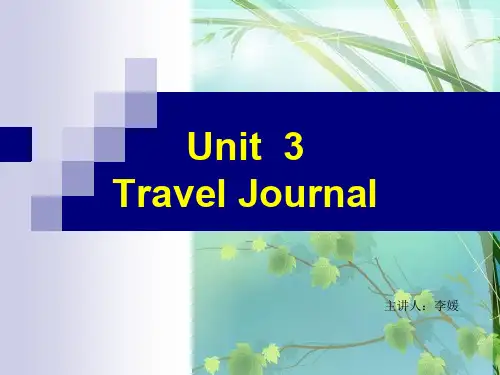
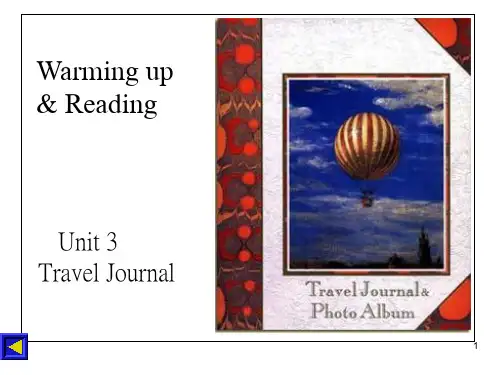

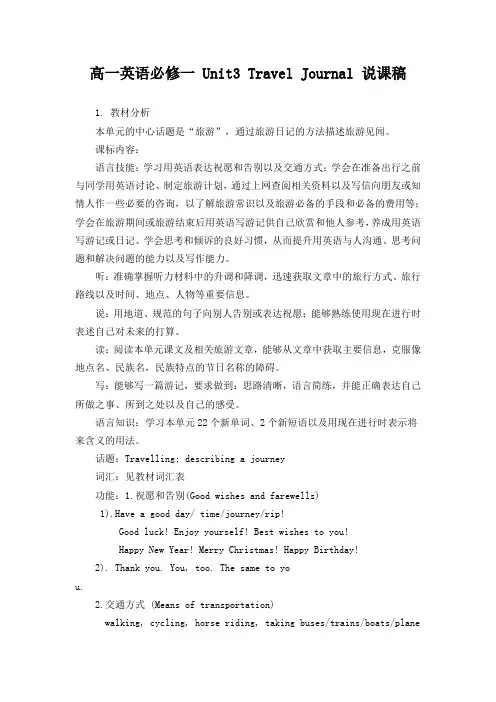
高一英语必修一 Unit3 Travel Journal 说课稿1. 教材分析本单元的中心话题是“旅游”,通过旅游日记的方法描述旅游见闻。
课标内容:语言技能:学习用英语表达祝愿和告别以及交通方式;学会在准备出行之前与同学用英语讨论、制定旅游计划,通过上网查阅相关资料以及写信向朋友或知情人作一些必要的咨询,以了解旅游常识以及旅游必备的手段和必备的费用等;学会在旅游期间或旅游结束后用英语写游记供自己欣赏和他人参考,养成用英语写游记或日记、学会思考和倾诉的良好习惯,从而提升用英语与人沟通、思考问题和解决问题的能力以及写作能力。
听:准确掌握听力材料中的升调和降调,迅速获取文章中的旅行方式、旅行路线以及时间、地点、人物等重要信息。
说:用地道、规范的句子向别人告别或表达祝愿;能够熟练使用现在进行时表述自己对未来的打算。
读:阅读本单元课文及相关旅游文章,能够从文章中获取主要信息,克服像地点名、民族名,民族特点的节日名称的障碍。
写:能够写一篇游记,要求做到:思路清晰,语言简练,并能正确表达自己所做之事、所到之处以及自己的感受。
语言知识:学习本单元22个新单词、2个新短语以及用现在进行时表示将来含义的用法。
话题:Travelling; describing a journey词汇:见教材词汇表功能:1.祝愿和告别(Good wishes and farewells)1).Have a good day/ time/journey/rip!Good luck! Enjoy yourself! Best wishes to you!Happy New Year! Merry Christmas! Happy Birthday!2). Thank you. You, too. The same to you.2.交通方式 (Means of transportation)walking, cycling, horse riding, taking buses/trains/boats/plane语法:现在进行时表示将来When are you leaving?How are you going there?Where are you staying?How long are you staying there?When are you coming back?情感态度和价值观:通过课文的学习,要求同学们能够积极参与关于旅行准备、旅游见闻、旅游感受等方面的交流活动,用准确的英语描述国内外的重要景观、名胜古迹以及一些当地的旅游文化节日。
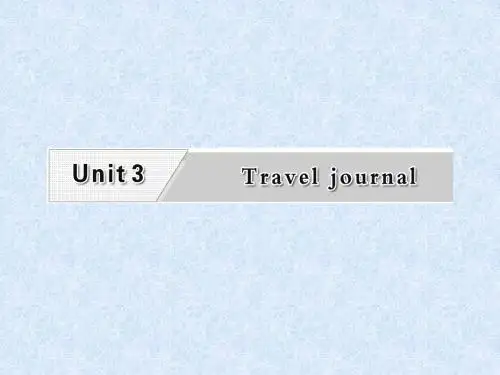
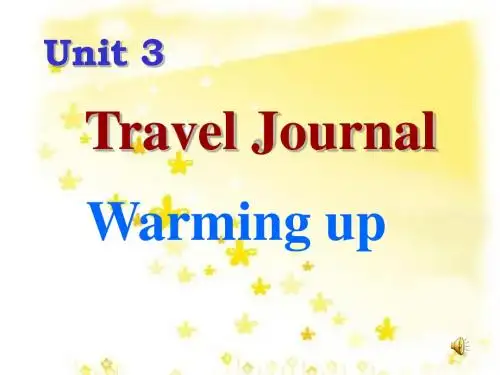
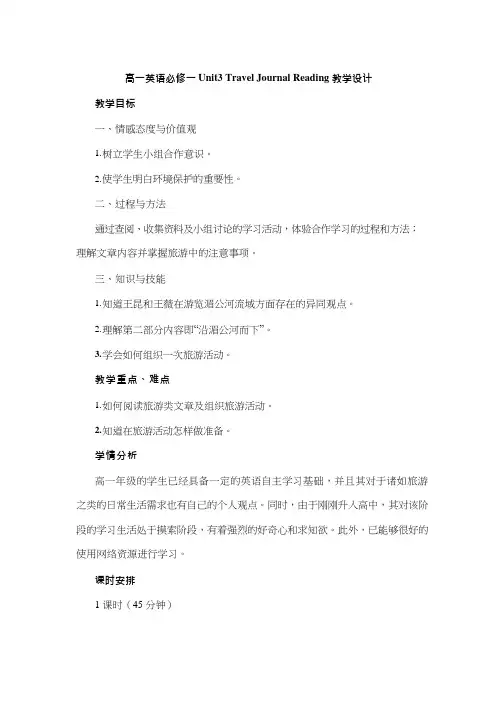
高一英语必修一Unit3 Travel Journal Reading 教学设计教学目标一、情感态度与价值观1.树立学生小组合作意识。
2.使学生明白环境保护的重要性。
二、过程与方法通过查阅、收集资料及小组讨论的学习活动,体验合作学习的过程和方法;理解文章内容并掌握旅游中的注意事项。
三、知识与技能1.知道王昆和王薇在游览湄公河流域方面存在的异同观点。
2.理解第二部分内容即“沿湄公河而下”。
3.学会如何组织一次旅游活动。
教学重点、难点1.如何阅读旅游类文章及组织旅游活动。
2.知道在旅游活动怎样做准备。
学情分析高一年级的学生已经具备一定的英语自主学习基础,并且其对于诸如旅游之类的日常生活需求也有自己的个人观点。
同时,由于刚刚升入高中,其对该阶段的学习生活处于摸索阶段,有着强烈的好奇心和求知欲。
此外,已能够很好的使用网络资源进行学习。
课时安排1 课时(45 分钟)授课方法讲授法、小组讨论与展示教学资源 多媒体课件 教学过程Step 1 Greeting Step 2 RevisionT :First ,I’ll ask some of you to give the answers to the exercises in Part 1 on Page 57.Suggested answers : are going/will go/am going to stay/will stay/am staying is going to fly/will fly/is f lyingis going to take/will take/is taking ;leaves is giving ;is saying am comingare ;going ;are ;getting bought ;will buy/are going to buy ;met ;will meet/are meeting/are going to meetStep 3 Lead inT : Here is good news.Your favorite singer Jay will give performances in Wuxi Stadium.But tomorrow you will take an English exam.What will you do ? S 1:Forget the exam and enjoy the concert first.S 2 : Forget the concert.Get well prepared for the exam.I can enjoy another concert of his some day.S 3:... S 4:...T : So we can see different students have different ideas , or different students hold different attitudes. ( Write “hold a...attitude” on the blackboard ).Do you know what an attitude is ?S :An attitude is what a person thinks about something.T :Yes ,usually different people hold different attitudes.Let’s turn back to Part One of this unit and make a comparison between Wang Kung’s and Wang Wei’s attitudes toward the trip along the Mekong.Present the chart on the screen ;then give Ss a few minutes to discuss.difference设计意图:以练习的形式通过复习上节课内容,加深学生对重点句型的理解和应用。
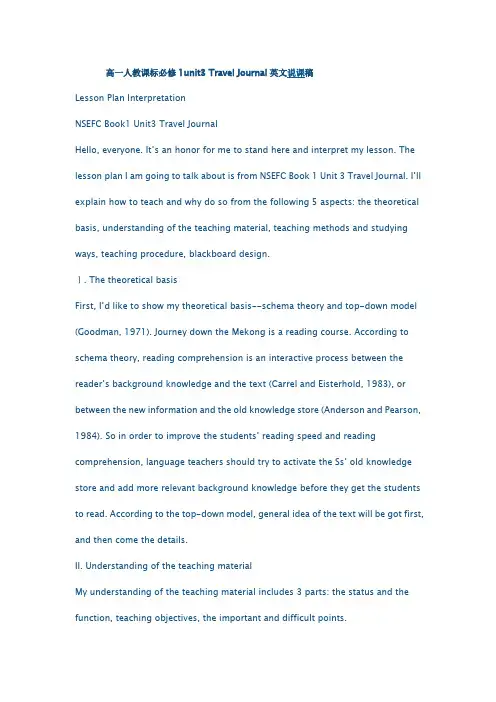
Lesson Plan InterpretationNSEFC Book1 Unit3 Travel JournalHello, everyone. It’s an honor for me to stand here and interpret my lesson. The lesson plan I am going to talk about is fro m NSEFC Book 1 Unit 3 Travel Journal. I’ll explain how to teach and why do so from the following 5 aspects: the theoretical basis, understanding of the teaching material, teaching methods and studying ways, teaching procedure, blackboard design.Ⅰ. The theoretical basisFirst, I’d like to show my theoretical basis--schema theory and top-down model (Goodman, 1971). Journey down the Mekong is a reading course. According to schema theory, reading comprehension is an interactive process between the reader’s bac kground knowledge and the text (Carrel and Eisterhold, 1983), or between the new information and the old knowledge store (Anderson and Pearson, 1984). So in order to improve the students’ reading speed and reading comprehension, language teachers should tr y to activate the Ss’ old knowledge store and add more relevant background knowledge before they get the students to read. According to the top-down model, general idea of the text will be got first, and then come the details.II. Understanding of the teaching materialMy understanding of the teaching material includes 3 parts: the status and the function, teaching objectives, the important and difficult points.At the beginning, let’s focus on the first part. Journey down the Mekong is a piece of travel j ournal written by Wang Kun. It’s mainly about Wang Kun and his sister’s dream of taking a great bike trip down the Mekong River, their preparation for the trip and some more details of the Mekong River. General speaking, it is not difficult for the students to understand the text, but there are some new phrases and sentences that may be a little bit difficult. So before the students’ first reading, I will explain the new words and phrases briefly and after reading the whole passage, I will embody the usage of the news words and phrases, and get the student understand the difficult sentences. As it is a piece of journal, besides learning the new words and phrases, students can get the general idea of how to write a journal.That’s all for the first part, now let’s move to the second part. According to the teaching material and the new curriculum of English, in order to fulfill the learning task of this lesson, I establish the following objectives:a) Knowledge objectivesBy the end of the lesson, Ss will have a better understanding of the meaning and structure of the text. Then Ss will grasp some useful words and expressions such as determined, make up one’s mind, give in, be fond of …, care about…, stubborn, etc.b) Ability objectivesActually students should be encouraged to do speed reading in the first period of reading lesson. But the students in my class are lack of independent readingability. In this class, I will encourage and help them to read, think and find out information by themselves most time. Since the main objective of reading course is to improve the Ss’ reading ability, I’ll train their ability of identifying the general idea in the fast reading. And in intensive reading their ability ofinformation-gathering and summarizing is developed. And the whole class is for Ss to develop their reading skills as scanning, skimming, information-gathering, summarizing and guessing the new words from the text.c) Moral objectivesThough Journey down the Mekong is mainly about the trip down the river, it also talks about the scenery and life along the river. So before learning the text, we will have a short discussion about the importance of the river. I want the Ss to have the awareness of protecting the river and protecting our environment.Well, so much for the teaching objectives, let's come to deal with the third part: the important points and the difficult points. According to the national curriculum of English and language learning theory, when teaching reading, we should encourage the Ss to do speed reading for the first time, that’s to say, we should encourage our Ss to read as fast as they can when they do the first reading. So much emphasis should be put on reading skills and reading comprehension as well. So the important points are that how to make Ss grasp the new words and phrases and how to improve their reading skills as scanning, skimming, information-gathering and summarizing. As to the difficult points, they are the same as the important ones.III. Teaching methods and studying waysThat’s all for my understanding of the teaching material. Now let’s focus on the ways of teaching and learning.Generally speaking, I adopt task-based language teaching and communicative approach in my class. As for learning, Ss will learn through independent reading, discussing and cooperating.I will use computer and blackboard as my teaching aids.Ⅳ. Teaching procedureHere comes the most important part, the teaching procedure. It includes 5 steps: Step I: Lead-in and pre-reading, Step II: While-reading, Step III: Consolidation, Step IV: Post-reading, Step V: Homework.Step I: Lead-in and pre-reading (7mins)Now let’s come to the first step. There are three activities in this step and I will spend 7mins on them.In activity one, I will ask Ss two questions "Do you know some great rivers in China?" and "Why they are great?” Here, as the Ss get famili ar with the Chinese great rivers, I choose to ask them some great rivers in China. And the answer to the second question can lead in the next activity--brainstorming.In activity two, I will ask the Ss to discuss in pairs and answer the question "How do pe ople who live along a river use it?” My purpose of this activity is to remind the Ss the importance of the river, thus stimulate the Ss' awareness of protecting the rivers.In the last activity, I will show the Ss a picture of the Mekong River and ask them to list the countries that it flows through. This activity leads in the while-reading. Step II: While-reading (21mins)While-reading is the main part and it will take 21mins. Here I adopt the top-down reading model. This step is divided into 2 parts: fast reading and careful reading. Before reading, I will ask the Ss to predict what will talk in the text according to the title. It can exert the Ss' imagination.1) Fast readingDuring fast reading, I will ask the Ss to reading the whole passage quickly and get the main idea of each paragraph. Usually, the main idea of each paragraph is the first sentence or the last sentence, but this text is not. So the main idea of each paragraph will be matched because the Ss are lack of the skill of summarizing the main idea by themselves.2) Careful readingAfter getting the general idea of each Para., I will deal with the details Para. by Para..In paragraph one, I will ask the Ss to read quickly and do the exercises T or F. And if it is F, I will ask them to correct it. This exercise can help the Ss get the key information of the first paragraph in a short time and can deepen the Ss’ understanding of the first paragraph.In paragraph two, I will ask Ss one question “Is it a difficult journey to cycle along the Mekong? W hy?” This can help the Ss develop their ability of summarizing. If theSs can’t answer the question briefly, I will encourage them to find the key sentences and try to join them together.And in the last paragraph, I will ask Ss two questions “How does th e water of Mekong River change?” and “What can you see when you travel along the Mekong River?” Both questions are required to answer in keys word. In order to lower the difficulty of the questions, I will show them the examples. After that, I will present some pictures to deepen the Ss’ impression on the new words. And these two questions can help the Ss gain a deeper understanding on the Mekong River. Step III: Consolidation (6mins)After dealing with the detailed information of each paragraph, I will ask the Ss to read the whole passage again and answer two questions to consolidate what they’ve learnt. It will take 6 minutes. The two questions are “Where is the source of the Mekong River and which sea does it enter?” and “How do Wang Kun and Wang Wei prep are for the trip?” It is easy for the Ss to find the answer to the first question in the text. As to the second question, it may be a little difficult, so I will list some tips for the Ss to find the answer more easily.Step IV: Post-reading (10mins)That’s all for the while-reading. Now let’s move to the fourth step. In this step, I will design two activities and I will spend 10 minutes on them.The first activity is filling in the blanks. In this activity, Ss are required to find the different attitudes of Wang Kun and Wang Wei to the trip, and then the teacher will express her attitude to this trip. After demonstrating, Ss are encouraged toexpress their attitudes. It can help the Ss train their ability ofinformation-gathering and expression.The second activity is thinking. In this activity, I will ask the Ss to discuss in groups of four and try to use some words to describe the characteristics of Wang Kun and Wang Wei according to their attitudes. It is really difficult, but it can not only train their ability of analysis and comprehension, but also cultivate their spirit of cooperationStep V: Homework (1min)Finally it comes to the homework. Ss are required to review the learnt lesson and underline the useful words and phrases in the text. This one is for them to consolidate what they’ve learnt and make preparation for the next lesson—Learning about the Language..Ⅴ. Blackboard designOn the top, there is the title of this lesson. On the left, it lists some important roles that the river plays. On the right, there are some useful words and expressions. That’s all for my interpretation. Thank you for your att ention。
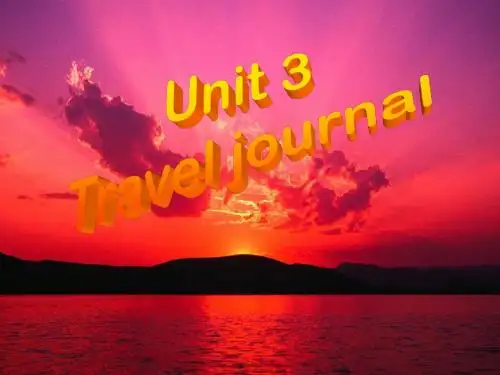
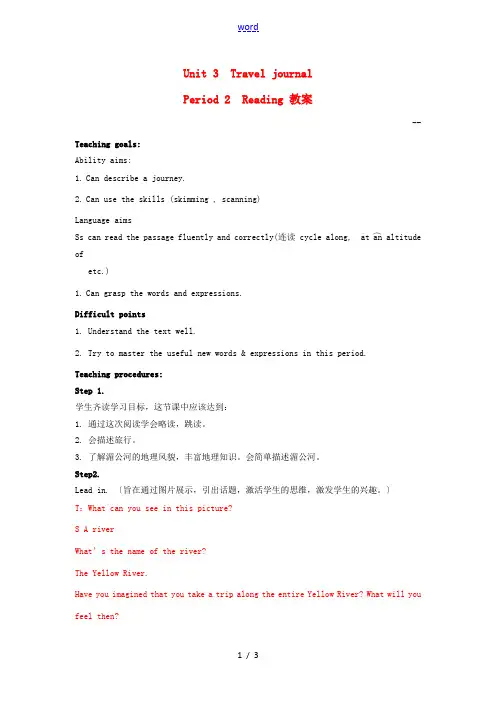
︵ ︵ Unit 3 Travel journalPeriod 2 Reading 教案--Teaching goals:Ability aims:1. Can describe a journey.2. Can use the skills (skimming , scanning)Language aimsSs can read the passage fluently and correctly(连读 cycle along, at an altitudeofetc.)1. Can grasp the words and expressions.Difficult points1. Understand the text well.2. Try to master the useful new words & expressions in this period.Teaching procedures:Step 1.学生齐读学习目标,这节课中应该达到:1. 通过这次阅读学会略读,跳读。
2. 会描述旅行。
3. 了解湄公河的地理风貌,丰富地理知识。
会简单描述湄公河。
Step2.Lead in. 〔旨在通过图片展示,引出话题,激活学生的思维,激发学生的兴趣。
〕 T :What can you see in this picture?S A riverWhat ’s the name of the river?The Yellow River.Have you imagined that you take a trip along the entire Yellow River? What will you feel then?S1.May be I will feel excited.S2.Surprised by its beauty....T: Just now, most of you use many different words to describe your feelings , such as, excited, surprise..., In a word, you imagine the trip must be exciting. It is so accidental that a student named Wang Kun is planning to take a trip along the MekongRiver. Doyou know where the MekongRiver is?S. Yes.T: Goood, Yes you have the information about MekongRiver. Please tell me something about it..Yellow River→ Mekong RiverA short introduce the MekongRiver.Now, you must want to know what Wang Kun is planning for the trip. Let’s e to the passage.Step3 Reading〔设计skimming和scanning旨在引导学生快速浏览文章,从总体上把握文章的框架结构和主题结构。